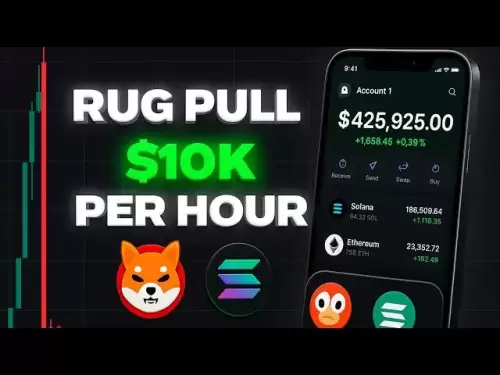-
 Bitcoin
Bitcoin $117700
-0.03% -
 Ethereum
Ethereum $3805
0.49% -
 XRP
XRP $3.098
-1.00% -
 Tether USDt
Tether USDt $1.000
0.03% -
 BNB
BNB $792.8
-1.72% -
 Solana
Solana $177.9
-1.95% -
 USDC
USDC $1.000
0.02% -
 Dogecoin
Dogecoin $0.2202
-1.55% -
 TRON
TRON $0.3278
-2.92% -
 Cardano
Cardano $0.7641
-2.43% -
 Hyperliquid
Hyperliquid $42.21
-2.68% -
 Sui
Sui $3.758
-1.58% -
 Stellar
Stellar $0.4080
-3.21% -
 Chainlink
Chainlink $17.75
-0.33% -
 Bitcoin Cash
Bitcoin Cash $591.8
4.96% -
 Hedera
Hedera $0.2561
-3.09% -
 Avalanche
Avalanche $23.34
-4.24% -
 Litecoin
Litecoin $110.7
1.96% -
 UNUS SED LEO
UNUS SED LEO $8.956
-0.01% -
 Toncoin
Toncoin $3.410
0.79% -
 Ethena USDe
Ethena USDe $1.001
0.03% -
 Shiba Inu
Shiba Inu $0.00001288
-1.82% -
 Uniswap
Uniswap $10.07
-2.06% -
 Polkadot
Polkadot $3.807
-2.27% -
 Monero
Monero $308.2
-2.15% -
 Dai
Dai $1.000
0.03% -
 Bitget Token
Bitget Token $4.521
-0.30% -
 Pepe
Pepe $0.00001134
-1.52% -
 Cronos
Cronos $0.1457
0.65% -
 Aave
Aave $274.9
-2.47%
Bitcoin contract gameplay skills
For successful Bitcoin contract trading, choosing the right exchange is crucial, considering fees, liquidity, security, and additional features.
Nov 13, 2024 at 08:31 am

Bitcoin Contract Gameplay Skills: A Comprehensive Guide
Bitcoin contracts, also known as perpetual swaps or futures, allow traders to bet on the future price of Bitcoin without owning the underlying asset. They are a powerful tool that can be used to generate profits, but they can also be risky if not used properly.
In this comprehensive guide, we will discuss the basics of Bitcoin contract gameplay, including how to choose the right exchange, how to open and close positions, and how to manage risk. We will also provide some advanced trading strategies that can help you improve your profitability.
1. Choosing the Right Exchange
The first step to successful Bitcoin contract trading is choosing the right exchange. There are many different exchanges to choose from, each with its own advantages and disadvantages.
When choosing an exchange, you should consider the following factors:
- Fees: Exchanges charge different fees for trading Bitcoin contracts. Some exchanges offer lower fees, but they may have less liquidity or a less user-friendly interface.
- Liquidity: Liquidity refers to the amount of trading activity on an exchange. Exchanges with high liquidity will have tighter spreads and faster execution times.
- Security: Security is paramount when choosing an exchange. You should only trade on exchanges that have a strong reputation for security.
- Features: Some exchanges offer additional features, such as stop-loss orders and margin trading. These features can be useful for managing risk and improving profitability.
2. Opening a Position
Once you have chosen an exchange, you can open a position. To open a position, you need to decide on the following:
- The type of contract: There are two types of Bitcoin contracts: perpetual swaps and futures. Perpetual swaps have no expiration date, while futures contracts expire on a specific date.
- The direction of the trade: You can open a long position if you believe the price of Bitcoin will rise, or a short position if you believe the price of Bitcoin will fall.
- The size of the position: The size of your position is the amount of Bitcoin you are betting on.
3. Closing a Position
You can close a position at any time by placing an opposite order. For example, if you have a long position, you can close it by placing a short order.
When you close a position, you will either make a profit or a loss. The profit or loss is calculated as the difference between the opening and closing prices of the contract.
4. Managing Risk
Risk management is essential for successful Bitcoin contract trading. There are a number of different risk management techniques that you can use, including:
- Stop-loss orders: Stop-loss orders are used to limit your losses in the event of a sudden price movement.
- Margin trading: Margin trading allows you to borrow funds from the exchange to increase your trading power. However, margin trading can also increase your risk of losses.
- Hedging: Hedging is a strategy that can be used to reduce your risk exposure. By hedging, you can create a position that offsets the risk of another position.
5. Advanced Trading Strategies
Once you have mastered the basics of Bitcoin contract trading, you can start to explore more advanced trading strategies. These strategies can help you to improve your profitability and reduce your risk.
Some of the most common advanced trading strategies include:
- Scalping: Scalping is a strategy that involves profiting from small price movements. Scalpers typically open and close their positions within minutes or even seconds.
- Day trading: Day trading is a strategy that involves opening and closing positions within the same day
Disclaimer:info@kdj.com
The information provided is not trading advice. kdj.com does not assume any responsibility for any investments made based on the information provided in this article. Cryptocurrencies are highly volatile and it is highly recommended that you invest with caution after thorough research!
If you believe that the content used on this website infringes your copyright, please contact us immediately (info@kdj.com) and we will delete it promptly.
- Bitcoin, Penguins, and Meme Coins: A Wild Ride in Crypto Town
- 2025-07-31 16:30:14
- Whale Movement and Altcoins: Buying Pressure Heats Up!
- 2025-07-31 16:30:14
- XRP, AI, and Price Projections: Decoding the Crypto Future
- 2025-07-31 15:10:13
- XRP Investment: Expert Opinions and the Potential for Explosive Growth
- 2025-07-31 15:15:12
- XRP Price: Whale Buys and Token Scoops—What's Next?
- 2025-07-31 15:30:12
- Imagen Network, RLUSD Payments, and Decentralized Applications: A New Era of Web3?
- 2025-07-31 14:30:12
Related knowledge

How to avoid common crypto investment mistakes?
Jul 13,2025 at 01:35am
Understanding the Risks of Crypto InvestmentInvesting in cryptocurrency can be highly rewarding, but it also comes with significant risks. One of the ...

What is a long-short crypto strategy?
Jul 15,2025 at 10:56am
Understanding the Basics of a Long-Short Crypto StrategyA long-short crypto strategy is an investment approach where traders simultaneously take long ...

What is a long-short crypto strategy?
Jul 11,2025 at 01:28pm
Understanding the Basics of Long-Short Crypto StrategyA long-short crypto strategy is an investment approach where traders take both long and short po...

How to use the RSI indicator for crypto?
Jul 12,2025 at 03:56pm
Understanding the RSI Indicator in Cryptocurrency TradingThe Relative Strength Index (RSI) is a momentum oscillator used to measure the speed and chan...

Is copy trading a good strategy for crypto beginners?
Jul 12,2025 at 08:28am
Understanding Copy Trading in the Cryptocurrency MarketCopy trading is a strategy where novice traders replicate the trades of experienced investors a...

How to build a crypto portfolio with $1000?
Jul 13,2025 at 08:14pm
Understanding the Basics of Cryptocurrency InvestmentBuilding a crypto portfolio with $1000 starts with understanding the fundamentals of cryptocurren...

How to avoid common crypto investment mistakes?
Jul 13,2025 at 01:35am
Understanding the Risks of Crypto InvestmentInvesting in cryptocurrency can be highly rewarding, but it also comes with significant risks. One of the ...

What is a long-short crypto strategy?
Jul 15,2025 at 10:56am
Understanding the Basics of a Long-Short Crypto StrategyA long-short crypto strategy is an investment approach where traders simultaneously take long ...

What is a long-short crypto strategy?
Jul 11,2025 at 01:28pm
Understanding the Basics of Long-Short Crypto StrategyA long-short crypto strategy is an investment approach where traders take both long and short po...

How to use the RSI indicator for crypto?
Jul 12,2025 at 03:56pm
Understanding the RSI Indicator in Cryptocurrency TradingThe Relative Strength Index (RSI) is a momentum oscillator used to measure the speed and chan...

Is copy trading a good strategy for crypto beginners?
Jul 12,2025 at 08:28am
Understanding Copy Trading in the Cryptocurrency MarketCopy trading is a strategy where novice traders replicate the trades of experienced investors a...

How to build a crypto portfolio with $1000?
Jul 13,2025 at 08:14pm
Understanding the Basics of Cryptocurrency InvestmentBuilding a crypto portfolio with $1000 starts with understanding the fundamentals of cryptocurren...
See all articles

























































































